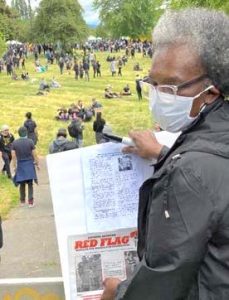Red Flag networks Key to Develop Communist Organizers here ♦ Communist networks in Pre-Revolutionary Russia here ♦

Red Flag Networks: Key to Developing Communist Organizers
In the 1970’s, Detroit autoworkers introduced me to the concept of socialist newspaper networks. These comrades expanded distribution within their factories by enlisting the help of sympathetic workers to circulate the paper.
So began a comrade’s reflections on what he has learned about revolutionary newspaper networks.
Today, the ICWP’s guiding principle of mobilizing the masses for communism opens up new possibilities. Red Flag networks go beyond expanding the distribution of our literature. They go beyond organizing class struggles, as militant as they may be. Red Flag networks are a vital aspect of building the communist relations we need to grow party collectives.
Our comrade continues:
Soon after I heard about the Detroit networks, I enlisted in the U.S. Army. During the Vietnam War era, the mission was to win soldiers to our party and ultimately to “turn the guns around.” But we faced an obstacle. It was illegal to distribute revolutionary literature in the armed forces.
To overcome this, we adapted the “Detroit networks” model to our military work. “Your party must be serious,” said my friend’s friend when he saw the paper and noted its wide-spread dissemination.
My friend was impressed. As we became “brothers in struggle” (his words), he joined our military collective.
Eventually, we recruited another soldier, creating a three-person multi-racial club. Despite courts-martial, imprisonment, FBI and U.S. Army Criminal Investigation Command harassment and constant attacks, our networks maintained the circulation of the paper. Not only did these networks spread our ideas, they also were able to organize open rebellion, sometimes fighting directly to spread the circulation of our paper.
After the army, I began work in a factory. My club again adapted the network model.
For a decade and a half, I went to work in a 12-passenger vanpool. Most in the vanpool read the paper. Readers who left the vanpool maintained contact; some continued distributing it.
Our organizing relied on this vanpool. For example, preparing for mass marches through the plants started there. Eventually, two Black women involved in this network joined the party.
One contract march is particularly notable. The 9/11 attack unleashed a torrent of U.S. nationalism, racism and reactionary politics. The union misleaders couldn’t mobilize workers, even for their pathetic reforms. With the aid of these networks, our small party collective rose to the occasion. Before the union traitors even knew what was happening, we organized a multi-racial march through the plants. Not a U.S. flag in sight!
The bosses were determined to stop the circulation of the paper. They threatened to fire readers and distributors. Anti-communist union misleaders helped management. But often the vanpool networks had spread party literature far and wide before these enemies could even get going. More importantly, some friends stood up to the anti-communist attacks directed at the paper.
These experiences are important everywhere in today’s conditions. Red Flag networks rely on activating all around us to spread communist ideas and to grow the collectives we already have. Our goal is to build one international party. Red Flag will help our networks unite the party internationally.
Active Red Flag networks are vital to developing new communist organizers and building enthusiasm for our communist mission. By participating in these networks, veteran and new comrades—as well as close political and social friends—will learn a lot about bringing communist ideas to the many varied battles against capitalism. These lessons are invaluable for every collective and comrade around the world.
Red Flag networks are necessary to maintain and build our collectives no matter what the bosses throw at us. The process of getting as many as possible to distribute Red Flag (either by hand or via the internet) will lead to wider discussions about the communist articles in the paper.
When our friends discuss articles with their friends, we need to write about these discussions for Red Flag. These kinds of letters and articles will encourage us to incorporate the struggle for communism into our lives.
There is no reason to limit Red Flag networks to the factories. Teachers, students, hospital workers, soldiers and others have employed this tactic to good effect. Some workers are very clear about this, taking scores of papers to family members and to their volunteer activities in the communities and schools.
Red Flag networks cannot be maintained without a collective struggle to develop communist relationships. These networks bring the party’s ideas and experience to workers worldwide, nurturing all our political and social relationships.
Communist relations on a mass scale will be a defining characteristic of our future communist society. These relationships allow us to function for the collective good without money defining our existence.
Red Flag networks will help develop communist relations among broader masses. In this period, they will not only help grow the party, but will give current and future comrades a taste of communist work.
Communist Networks in Pre-Revolutionary Russia
Illegal communist work in Russia, before the 1917 revolution, centered on the Bolshevik “All-Russian” newspaper Iskra and on communists’ relationships among the masses. “Can a newspaper be a collective organizer?” Lenin asked. Yes, he answered, and it’s absolutely necessary.
That’s how circles of workers and youth can engage in common work. Debate and organize around a common line. How the revolutionary communist party can develop relationships and establish lines of communication extending into far-flung factories and working-class districts. How it can be built up organizationally. How it can maintain a hard line and flexible tactics. How it can prepare for a revolutionary uprising.
Lenin explained this in Chapter V (parts B and C) of What Is to Be Done? (1902). This is not easy reading. Lenin was arguing against his critics, and it’s easy to lose the thread. But many party collectives will find it useful to read together.
Twenty Years in Underground Russia, by Cecilia Bobrovskaya, and other Bolshevik memoirs show how this worked in practice. Getting stacks of papers into a worker’s hands involved printing and transporting copies illegally. It meant hoping that one’s contacts hadn’t been arrested—and having backup plans.
As we often find today, many workers were illiterate, or not comfortable reading. Their literate comrades had to be able to read or at least explain the line to them. This usually couldn’t happen openly in a factory, but many workers lived near each other in the factory district – also like today.
Bolshevik organizers knew well that the essence of their work was developing leaders for networks of workers, who in turn would lead others. In this respect, our “Red Flag networks” today are the same.
The big difference between then and now is our concept of a mass party. We want the emerging leaders to become party members, fully engaged in the life of the Party, and not just supporters. Of course, we need these comrades to maintain discretion, security and discipline – just as the Bolsheviks expected from their “cadre.”
We have confidence in the potential of such a growing mass communist party to do more than distributing papers, more than leading communist class struggle, more than taking advantage of opportunities for insurrection and revolution. Unlike the Bolsheviks, who compromised with capitalists to build socialism, our party of a new type will be the core of a new and fully communist society.

